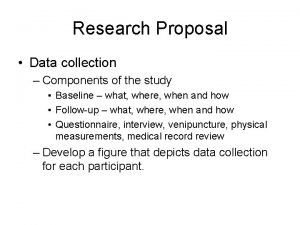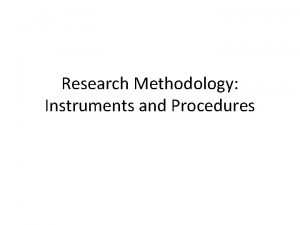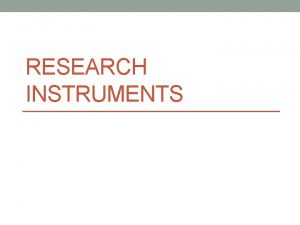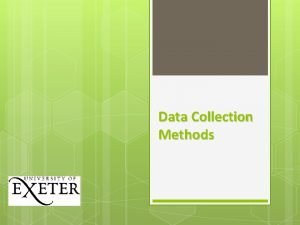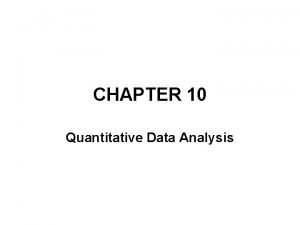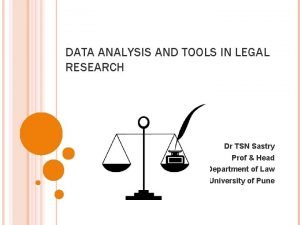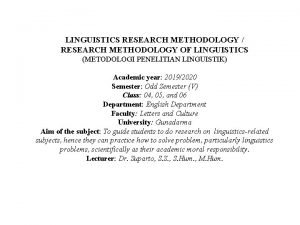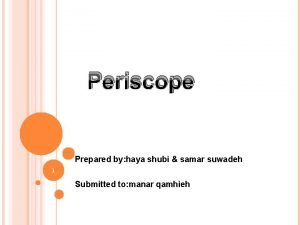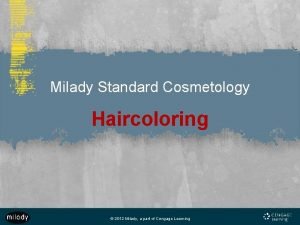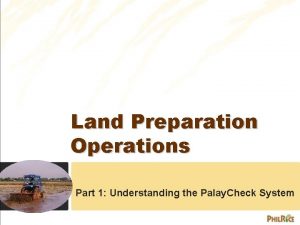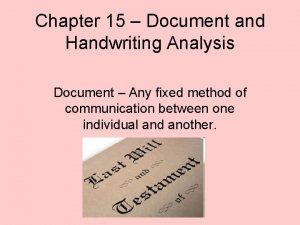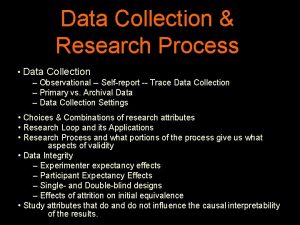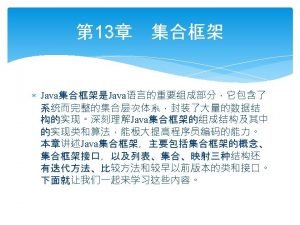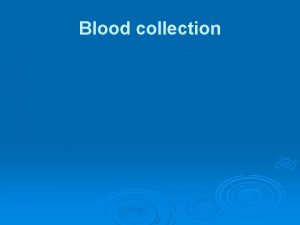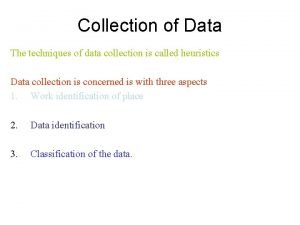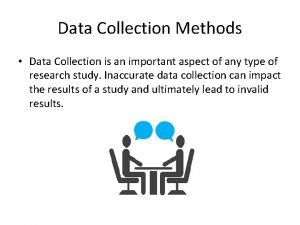Unit VIIII Data Collection in nursing research Prepared


























- Slides: 26

Unit VIIII: Data Collection in nursing research Prepared by: NUR 500 Research team 1 ST semester 38/39. H

OBJECTIVES On completing this Unit, you will be able to: - Outline the differences between structured and unstructured data collection methods - Explain two criteria for selecting a data collecting technique - Describe the major strengths and weaknesses for one type of data collection technique

Data Collection Plan v. Well designed data collection – Enhance the quality of the data – Ensure the usefulness of study evidence v. Poor quality data undermines study results “A prime consideration in selecting a data collection method should be the conceptual congruence between the constructs of interest & the method, and the quality of data that method yields” (Polit & Beck, 2017) Garbage In = Garbage Out Polit & Beck 2017

Data Collection Methods Most Common Approaches used in Nursing Research – Self Reports – Observation – Biophysiologic Measures Polit & Beck 2017

Types of Observation Data v. Scientific Structured Observation – Molar – Molecular v. Unscientific Unstructured Observation –Unknown –Participant Polit & Beck 2017

Data Collection Techniques v. Structured – Quantitative research studies – Data collected from study participants q Response categories are specified in advance üSelf administered questionnaires üInterviews üObservations Polit & Beck 2017

Scientific Observation v. Different than ordinary observations during daily life üObjective üSystematic üExamines specific behaviors, activities, conditions, & characteristics ØIdentify what you want to observe before you make the observation Polit & Beck 2017

Structured Observation v. Molar Approach: observe large units of behavior & treat them as a whole üCombining several verbal and nonverbal behaviors to determine one global behavior üSusceptible to observer error re: ambiguity in observations Polit & Beck 2017

Structured Observation v. Molecular Approach : Small, specific behaviors and/or verbal phrases are the observational units üReduces behavioral observations to concrete & specific elements ØAction, gesture, phase = separate entity üMay fail to understand how smaller elements contribute to the whole pattern Polit & Beck 2017

Unstructured Observation v. Most qualitative research studies v. Data collected from study participants ØInterview ü Participant asked questions without a predetermined plan regarding the content or flow of interview information ØObservation üNo formal, predetermined plan for observing, counting, naming, or recording the information Polit & Beck 2017

Unstructured Observation v. Unknown: concealed observation üReal-world setting data ØOne way mirrors, hidden cameras/people ØBehaviors might change if aware of researcher üUnethical when done without consent v. Participant: social interaction üParticipation in the observation of a group or culture Polit & Beck 2017

Interviews Unstructured Interviews Grand Tour Questions: Broad, open-ended question that leads to more focused questions guided by responses Descriptive Questions: Participants describe experiences in own words Contrast Questions: Differences between the meaning of terms & symbols Polit & Beck 2017

Interviews Focused or Semi-structured Interviews v. Pre-prepared written topic guide üList of areas or questions to be covered ØMay have follow-up or probing questions üParticipants speak to the listed topics freely and in their own words Polit & Beck 2017

Interviews Structured Interviews v. Instrument = interview schedule üQuestions asked orally via face-to-face or telephone interviews v. Various degrees of structure üOpen-ended vs. closed-ended questions: ØOpen: “What prevented you from making the appointment? ” ØClosed ended: rate, scale Polit & Beck 2017

Questionnaires Self Administered Questionnaires (SAG) v. Open and/or closed-ended questions distributed via in person, mail, e-mail, or web v. Advantages ü Reduced time and cost versus interviewing ü Anonymous ü Less interviewer bias ü Easy to analyze v. Disadvantages ü Low response rates ü Survey fatigue: too long or too many given Polit & Beck 2017

Scales v. Nurse researchers often use pre-existing scales that are valid and reliable, rather than develop their own ØMeasures degrees of something ØProduces a numeric score ØExamples: Likert, Visual Analogue v. Although some scales and instruments are either free or in the public domain, many must be purchased from the publisher or developer and/or require the author’s permission to use. Polit & Beck 2017

Scales Semantic Differential (SD) Scales v. Used to measure psychosocial traits v. Rate a concept on a series of bipolar adjectives üEffective/ineffective; active/passive, good/bad v. Advantages: flexible & easy to construct v Disadvantages: Adjective pairs can be inappropriately linked to the concepts Polit & Beck 2017

Scales Visual Analogue Scale (VAS) Polit & Beck 2017

Delphi Technique v. Survey technique for obtaining expert panel opinion & judgment on a specific topic or concern v. Individual experts are asked questions in a series of survey rounds üSummary data circulated between rounds üFinal goal: Expert consensus; forecasting v Example: Rand Corporation surveys Polit & Beck 2017

Delphi Technique v. Survey technique for obtaining expert panel opinion & judgment on a specific topic or concern v. Individual experts are asked questions in a series of survey rounds üSummary data circulated between rounds üFinal goal: Expert consensus; forecasting v Invented by Rand Corporation Polit & Beck 2017

Existing Databases v. Many healthcare institutions have preexisting databases with patient outcome measures and nurse sensitive indicators üQuality Improvement & Risk Management üCal. NOC (Collaborative Alliance for Nursing Outcomes) üFall, Pressure Ulcers, Restraints v. Economical method of measuring trends v. Quality of data entry and database maintenance has been questioned Polit & Beck 2017

Physiologic Measures v. Increased use of measures v. Assess biophysiologic status of patients v. Evaluate clinical outcomes v. Types of Measures üIn vivo: in or on living organisms ØBody temp, BP, HR, Oxygen Saturation üIn vitro: outside living organisms ØSerum lab values Polit & Beck 2017

Physiologic Measures Advantages v Accurate & precise, Objective v Valid measures of targeted variables üThermometer always measures temperature v Available equipment in most healthcare settings Disadvantages v Measuring tool might affect the variable üArterial line might block artery & alter pressure v Artifact interference v Possible Injury Polit & Beck 2017

Summary Available Resources Tool Reputation, Availability & Familiarity Tool Validity & Reliability Norms & Comparability Population Appropriateness Administration Issues Ethics – just because you can do, doesn’t mean you should do it! Polit & Beck 2017

Conclusion v. When selecting data collection methods & instruments consider the following: – Is the technique appropriate to the research question & study design? – Do you understand the practical, technical, financial, and ethical issues? v. Quality data collection methods ensure that data results are appropriate, accurate, robust, and MEANINGFUL Polit & Beck 2017

Question?
 Instruments in quantitative research
Instruments in quantitative research Data collection research proposal
Data collection research proposal Instruments in research methodology
Instruments in research methodology Research instrument example
Research instrument example Research instrument examples
Research instrument examples Statistical treatment of data example
Statistical treatment of data example Data analysis in legal research
Data analysis in legal research Research limitation example
Research limitation example What are the parts of a research proposal
What are the parts of a research proposal Landsat collection 1 vs collection 2
Landsat collection 1 vs collection 2 Documentary collection definition
Documentary collection definition Data collection procedures
Data collection procedures Data collection secondary data sources
Data collection secondary data sources Unit 6 review questions
Unit 6 review questions Agricultural research service culture collection
Agricultural research service culture collection Collection unit 4
Collection unit 4 The business plan should be prepared by
The business plan should be prepared by Two node loop instability
Two node loop instability Dramatic irony in act 4 of romeo and juliet
Dramatic irony in act 4 of romeo and juliet Haya shulman
Haya shulman What is a preliminary strand test
What is a preliminary strand test Land preparation activities
Land preparation activities Format of departmental account
Format of departmental account Noncommercial food service examples
Noncommercial food service examples Document
Document Wilson company prepared the following preliminary budget
Wilson company prepared the following preliminary budget Pictures of
Pictures of

